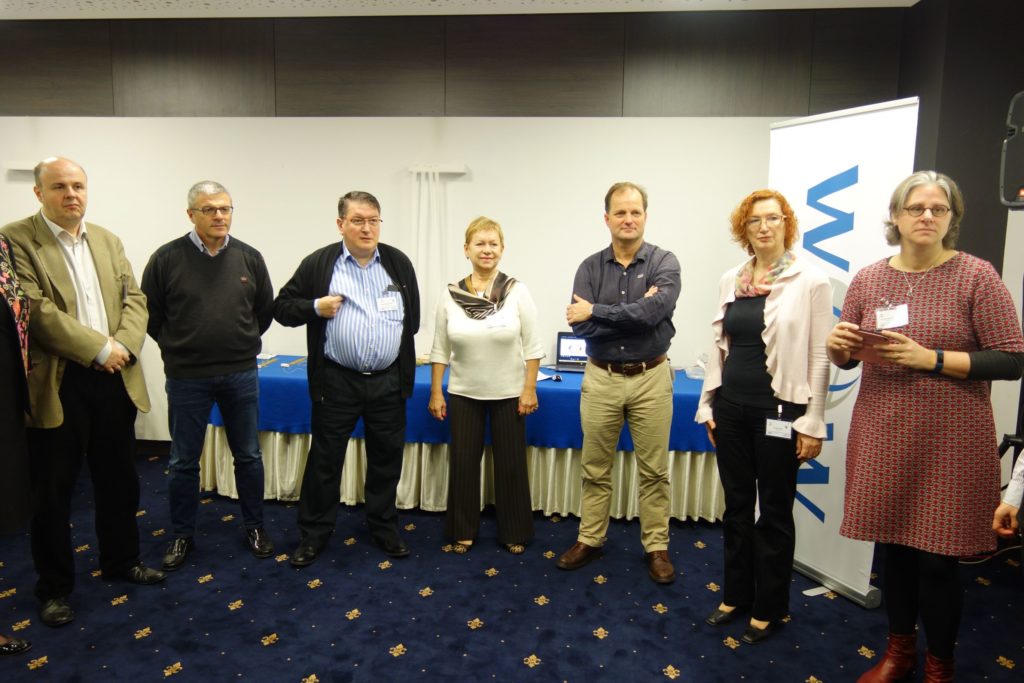From 21 – 24 November 2017 a Meet and Learn Workshop was organized in Sarajevo, Bosnia and Hercegovina. The workshop was organized by CNV Vakmensen, the World Organization of Workers and the Independent Trade Union Federation of Workers in Financial Organizations of Federation of BIH (Federation of BiH). The aim of the workshop was to bring together representatives of the companies making the funds available, and active in company work councils, and representatives of the trade unions and have them discuss different ways of negotiating.
Since many of us did not know each other the first actual point in the agenda was to get Getting acquainted through a game. In a very informal manner people found out each other names and the country of origin. It was a very positive way to start of the two-day workshop.
This was followed by an interactive presentation about negotiating in practice. The speakers were Mrs. Ike Wiersinga, Negotiator CNV Vakmensen, and Mr. Jan Jaap Krijtenburg, Compensation & Benefits manager Nationale Nederlanden Group (Netherlands). They explained the situation within the company Nationale Nederlanden when it comes to negotiating. This should not be a battle, although at times it may get rough. It should be about working together towards a result that is of benefit and interest to both. This is a complicated trajectory, requiring a lot of trust. But the results are carried by both sides of the spectrum making these results more valid and hopefully future-proof. It should be an innovative and inclusive process. And this is exactly what Nationale Nederlanden is trying to achieve. Through cocreation they are trying to find the best ground and the most support for the final outcome.
There are a number of factors for success of which a workable relationship between social partners is pivotal. Additionally the mindset should be right. It should be about interests and possibilities rather than opinions and restrictions. It further requires employee input and engagement. But in the end it all comes down to trust and mutual interests. And this is exactly where it often goes wrong. And certainly in countries where the social dialogue is not so incorporated in the system as it is in some other countries.
To put the information of the presentation into practice the participants were split in four groups. Two groups acted as employers and two others as employees. A case was presented and on the basis of that the groups had to negotiate as employers or employees. This was a first step. And it turned out to be a difficult step as some participants who were supposed to negotiate as employers tended to negotiate as if they were the employee. Additionally, it turned out be difficult since the idea was not to go to a result as soon as possible, but to take the time to follow a process and see what the respective interests were.
Later the two groups (employers and employees) were joined to discuss their results. The aim was to come to a result which would be supported by both sides. This was very complicated since one tends to want to go too fast, while not always listening very well to the other.
The process is difficult and requires patience, but it is pivotal to follow the rights steps to make it a success.
The second day started with three Interactive presentations about the practice of recruitment of members. One from the perspective of the trade union in Bosnia and Herzegovina, one from Serbia, and one from the Netherlands. The first two approaches were relatively similar, since the countries have a shared history. In the Netherlands this was quite different. The focus in the first two was the attraction of members and keeping them. Making people active. Being representative. Also because the fees of membership are essential for existence.
In the Netherlands this is also the case, but there were some differences too. The union should be visible and thus they offer tools for non-members too. This is a recurrent issue. Should we also be open to non-members. If you want to be representative yes, but financially this may have consequences. By offering additional services to members and not to non-members perhaps the difference can be made. Main thing remains presence and visibility. Knowing your constituency (be they member or not). Then you are representative.
Another issue is the image. This should be positive and constructive. Trade unions are often not perceived as something very positive because of some actions. By organizing positive campaigns changes can be made.
The participants were again asked to work in groups. This time to develop a campaign for recruiting members which could be applied to all the organizations. Not an easy task with delegates coming from more than ten different countries. Countries were the reality and legislation is different. But like the previous assignment it all comes down to negotiating. Not for a new CLA this time but to come to one campaign for all.
The workshop was a great success and clearly showed that negotiating is far from easy. Despite the level on which one negotiates. One always needs supporters of a certain path and one needs to convince others. But this convincing should not be by force or pressure but by finding commonalities of interest and work from there.
Countries, cultures and social relations may differ, but it would be very interesting to see what will happen when some of the results are used during negotiations in different countries. Of course applied to the national situation.
The Workshop was made possible by ABN AMRO, Nationale Nederlanden, ING, and Achmea. We sincerely thank them for making these funds available.
for pictures click here





